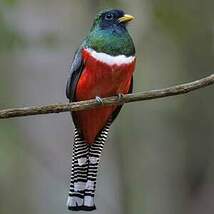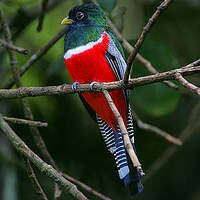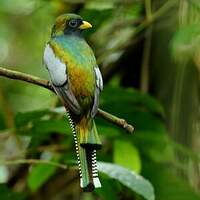Collared Trogon
Trogon collaris - Trogon rosalba
Identification
The Collared Trogon, an enigmatic name, the bird is known as Collared Trogon in nearly all languages except French! Perhaps Louis Jean Pierre Vieillot (1748-1831), the renowned French ornithologist who discovered the species in 1817, paid tribute to American painter and lithographer, Rosalba Peale (1799-1874) who was renowned for her bird works? A bit of mystery surrounding such a beautiful bird, measuring 25-29 cm, the distinct Collar gives its name to the species, which is subdivided into 8 subspecies. The dimorphism is very pronounced, the male has a strong yellow beak, with a slightly curved upper mandible and, like all trogonidae, beautiful black vibrisses. The eyes, surrounded by black like the parotids and the throat, have a rather thin orange-yellow orbital ring, the crown, mantle and back are emerald green. The scapulars are also green, then all the covers are adorned with a delicate horizontal black and white web pattern while the black remiges are clearly separated from each other by a white line. The throat and the beginning of the chest remain the same emerald green, an unmistakable white mark separates the chest from the venter, painted a remarkably intense red, the contrasts are even greater with the tail horizontally striped with black and white on its underside. Three distinct white spots are painted on the rectrices, the first about halfway down the tail, the other two at the extremities. The upper rectrices are pale green and contrast with the emerald green back. The legs, hardly visible, are grey. The female differs almost to the point of being a different bird: the yellow beak, like many female trogons (Trogon mexicanus or Massena's trogon) is adorned with a gray culmen. The eye is surrounded by a very clear white orbital ring, the parotids and the throat are anthracite.The crown, nape, mantle and back are a beautiful dark brown colour. The scapulars are light brown with dark brown mottles that are also found on the secondary remiges. The primary remiges are very dark brown, almost black, and have clear white margins. The female, wanting not to be outdone compared to her companion, presents a chest the same dark brown colour as the back, highlighted by a large horizontal white band. The belly and underside are red, with a lighter hue than the male. Even the tail is different, the upper rectrices are brown while the lower rectrices are grey with three horizontal white marks outlined in black, the outer edges of the rectrices are white, the tail finishing in a final black mark. Immature males will have coverts and remiges of a brown colour, a balanced black and white marking on the lower rectrices, while females will have a gradient of grey on the same feathers, the immatures more closely resembling the adult female colouration. There are eight subspecies, which, in addition to their location, present some differences among themselves: ssp collaris, giving its name to the species described in the previous lines; ssp puella, in Mexico and on either side of the Central American cordillera, is sometimes considered a distinct species, having a blue-green chest and a more finely striped dark and white tail; the female being lighter in all its tints, with notably an orange belly; the tail appearing mostly white, with grey-light brown in the centre; ssp extremus is smaller in the north-east of Panama; ssp heotinus with more prominent white marks on the tail and no orbital white circle on the Serrana del Darien to the north-west of Colombia; ssp virginalis to the west of Colombia and Ecuador, with a very bright blue-green back and faint white marks; the female being very light brown; ssp subtropicalis in Subtropical Colombia, with a greater wingspan and paler colouration than ssp virginalis; ssp exoptatus in the north of Venezuela, showing a copper green colouration on the back and chest and a longer tail; and ssp castaneus in Brazil, with scapulars and coverts a grey-black colour and coarser horizontal stripes. The species is known as the Collared Trogon.The observation location is essential for the differentiation of the ssp, or even other trogons, possible confusion with Mexican Trogon, Elegant Trogon, Masked Trogon and Collared Trogon.
Subspecific information 10 subspecies
- Trogon collaris collaris (Colombia to n Bolivia and wc Brazil, Guianas, Trinidad and Tobago)
- Trogon collaris puella (c Mexico to w Panama)
- Trogon collaris underwoodi (nw Costa Rica)
- Trogon collaris aurantiiventris (c Costa Rica, w Panama)
- Trogon collaris extimus (ne Panama)
- Trogon collaris heothinus (Darién. e Panama.)
- Trogon collaris virginalis (w Colombia, w Ecuador and nw Peru)
- Trogon collaris subtropicalis (c Colombia)
- Trogon collaris exoptatus (n Venezuela)
- Trogon collaris castaneus (se Colombia and nw Brazil to e Peru and n Bolivia, e Brazil)
Foreign names
- Trogon rosalba,
- Trogón acollarado,
- surucuá-de-coleira,
- Jungferntrogon,
- hegyi trogon,
- Gekraagde Trogon,
- Trogone dal collare,
- halsbandstrogon,
- Båndtrogon,
- trogón pásikavý,
- trogon límcový,
- Båndhaletrogon,
- käkitrogoni,
- trogon de collar,
- trogon obrożny,
- Ошейниковый трогон,
- クビワキヌバネドリ,
- 白领美洲咬鹃,
- halsbandstrogon,
- 白領美洲咬鵑,
Voice song and call
Habitat
Mainly at medium altitudes, from 700m in moist or semi-moist forests, at higher altitudes up to 2,400m, in cloud forests.
Behaviour character trait
Primarily sedentary, the Collared Trogon (Trogon rosalba) is known to move from Chiapas in Mexico at altitude to the Pacific and Atlantic coasts. In Costa Rica it has been seen from elevations of 2,800 meters as well as from the 150 meter mark on the Caribbean Sea coast or at the edge of the forest along the shores of the Pacific Ocean. Its disparate presence in Brazil shows that it roams, most likely in response to either the reproductive periods or to the abundance or scarcity of food.
Dietfeeding habits
It seems to be more insectivorous than other trogons; cicadas, scale insects, caterpillars and orthopterans are part of its diet, but it is also frugivorous and fond of Hasseltia floribunda berries, from the Salicaceae family, which are found from southern Mexico to southern Brazil, which is its distribution area. Besides these berries, it seeks out the fruits of Rubus or brambles, which are actually from the family of blackberries or raspberries.
Reproduction nesting
From March to June in Mexico, from January to April in Costa Rica, from November to December in Guyana, the Collared Trogon looks for a dead or decaying tree to build its nest in.
It may also make use of an abandoned termite mound, like the Massena Trogon. The clutch is of two to three eggs, incubated for 16 days. Unfortunately, there is very little known about the reproduction of the Trogonidae and especially of the Collared Trogon; We can only notice the brown coloring of the female which makes it almost invisible to our eyes and to the eyes of predators as it incubates!Geographic range
Throughout southern Mexico, all countries of Central America, South America, Colombia, Venezuela, Ecuador, Surinam, Trinidad and Tobago, throughout the Amazonian region of Peru, Bolivia, in Guyana and Brazil, the Collared Trogon (Trogon rosalba) is found with a very scattered distribution, in Amazonia, in the Atlantic coast extending completely east of Brazil, several observations in the middle of the country and in the Pantanal.
Threats - protection
IUCN conservation status
concern
in the Wild
threatened
evaluated
Common bird pass from several Central American countries to the most rare Trogon in the Yucatan! Countries that give a lot of importance to conservation, such as Costa Rica, conserve the trogons, and of course the Collared Trogon. However, deforestation, population growth, and the use of pesticides are reducing its range, be careful not to wake up with the obligation to put the Collared Trogon in the NT or worse VU!
Sources of information
- IOC World Bird List (v15.1), Gill, F and D Donsker (Eds). 2025-12-07.
- Birds of Mexico Central America, Ber Van Perlo
- Birds of Peru, Thomas S.Schulenberg, Douglas F.Stotz, Daniel F.Lane, John P.O'Neill, Theodore A.Parker III
- A Field Guide to the Birds of Brazil, Ber Van Perlo
- Vol. 6 - Handbook of the Birds of the World, Josep del Hoyo-Andrew Elliott-Jordi Sargatal
- xeno-canto, Sharing bird sounds from around the world,
- Arthur Grosset's Birds, Arthur Grosset
- Avibase, Lepage Denis
- THE AVIANWEB, Sibylle Faye
- Wikipédia, Wikipedia, The Free Encyclopedia
- A Natural history of the Trogonidae, Joseph M.Forshaw Albert Earl Gilbert
Other sources of interest
 Specification sheet created on
31/07/2023 by Anne et Gabriel Leboff
Specification sheet created on
31/07/2023 by Anne et Gabriel LeboffTranslation by AI Oiseaux.net
© 1996-2025 Oiseaux.net
- Accipitriformes
- Aegotheliformes
- Anseriformes
- Apodiformes
- Apterygiformes
- Bucerotiformes
- Caprimulgiformes
- Cariamiformes
- Casuariiformes
- Charadriiformes
- Ciconiiformes
- Coliiformes
- Columbiformes
- Coraciiformes
- Cuculiformes
- Eurypygiformes
- Falconiformes
- Galliformes
- Gaviiformes
- Gruiformes
- Leptosomiformes
- Mesitornithiformes
- Musophagiformes
- Nyctibiiformes
- Opisthocomiformes
- Otidiformes
- Passeriformes
- Pelecaniformes
- Phaethontiformes
- Phoenicopteriformes
- Piciformes
- Podargiformes
- Podicipediformes
- Procellariiformes
- Psittaciformes
- Pterocliformes
- Rheiformes
- Sphenisciformes
- Steatornithiformes
- Strigiformes
- Struthioniformes
- Suliformes
- Tinamiformes
- Trogoniformes
































